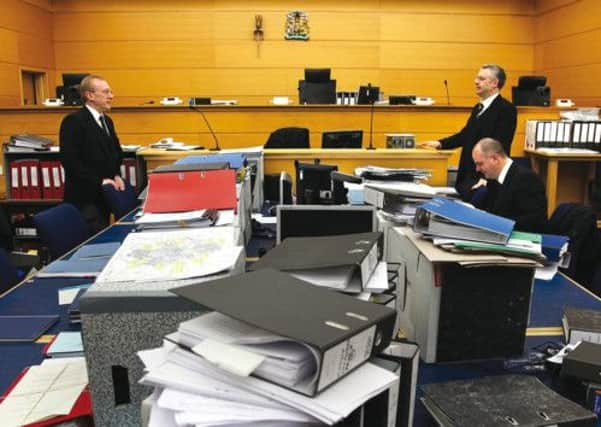Dani Garavelli: Acquittal for justice on the box


This was, admittedly, based largely on watching the grandstanding at the trials of OJ Simpson and Michael Jackson’s doctor Conrad Murray, neither of which were representative of the justice system as a whole. But then neither was Fraser’s. Fewer than 1% of cases in Scotland are heard by a jury, fewer still involve a charge of murder, and even as murder trials go, this one was atypical, given there was no body, the defendant had an alibi and the prosecution case was founded entirely on circumstantial evidence.
There are many valid reasons to oppose allowing cameras into a court; one is that both witnesses and lawyers may be inclined to play up to the gallery, conscious of the potential for reputations to be made or destroyed. Imagine, for example, how much more some of the key players in the Sheridans’ perjury trial would have made of the time they spent testifying if they’d known their performance would be aired in front of an audience of several million. Then there is the issue of editing; the judgment over what to include and what to strike out is a subjective one and, even if you are sincere in your attempts to give the viewer an insight into the workings of the justice system, you still have to keep them interested.
Advertisement
Hide AdAdvertisement
Hide AdI was particularly sceptical about The Murder Trial because I knew it was being broadcast as a complete package put together after the verdict had been delivered rather than as the case unfolded. Not only had a six-week case been condensed to 90 minutes, the footage from the courtroom had been intercut with interviews with her family, which smacked of emotional manipulation. How would the audience be able to weigh up the evidence put before the court in the dispassionate manner required of a juror if tearful relatives were allowed to describe their enduring grief?
However, when I saw the programme most of my qualms disappeared. Far from playing up the moments of potential drama – such as after the verdict, when Fraser’s previous conviction for assaulting Arlene was revealed – The Murder Trial pointed up the yawning gap between the enormity of the crime and the often humdrum nature of the evidence on which justice often hangs. So the programme focused as much on photographs of the empty rooms of the Fraser family home and the recollection of Nat Fraser’s “lorry boy” that the day on which Arlene disappeared seemed entirely normal as it did on the moment star prosecution witness Hector Dick was threatened with contempt of court for refusing to answer questions.
Aficionados of US crime dramas would have found the deliveries of prosecution and defence QCs Alex Prentice and John Scott surprisingly muted. Nor was the process unduly adversarial. Yet, if anything, the fact the guilty verdict relied more on the careful threading together of various strands of evidence than on the overblown rhetoric of a couple of egotists made it even more gripping.
The selective nature of the testimony also highlighted the fact that trials are not a forum for witnesses to come to terms with traumatic experiences or an attempt to provide a comprehensive account of a tragedy – they require the exposition only of such information as will advance the prosecution or defence case. For this reason, the contextualisation provided by the photographs of Arlene and interviews with her family was an asset; it reminded us that what happens inside a courtroom is not the full story.
Of course, much depends on the spirit in which you watch such programmes and there’s no accounting for some people’s inanity; after it aired, some suggested the best approach to real-life trials was to fast-forward through the “boring bits”.
Overall, though, I thought the documentary had the potential to enhance the public understanding of the Scottish justice system, even to the point of highlighting its imperfections. Who could have watched it without wondering about the ethics of the trade-off which saw Dick, who admitted sourcing a car for Fraser and then burning it and was originally charged alongside him, turn Queen’s Evidence to secure his conviction? Or asking themselves if it is satisfactory that a case which hinges on the testimony of a proven liar should be decided on a majority verdict which could have been as close as 7/8?
Even now, I wouldn’t be in favour of having cameras in courts as a matter of course. Nor would I want to see trials broadcast contemporaneously as they are in the US. It would be a travesty if the justice system was turned into a reality TV show.
But every so often, I think it’s a good idea to let the public watch the wheels of justice turn. Only next time, perhaps it would be fairer if it featured something a little more representative of the regular goings-on – a day in the life of a sheriff court, perhaps, with an array of gallus characters up for shoplifting or decking a friend. Or, if they’re dead set on a murder, then a bog-standard stabbing – the kind of trial where the defendant has no alibi, there’s plenty of forensics and it’s easy to distinguish the man in the dock from the lawyers sitting around him. «
Twitter: @DaniGaravelli1